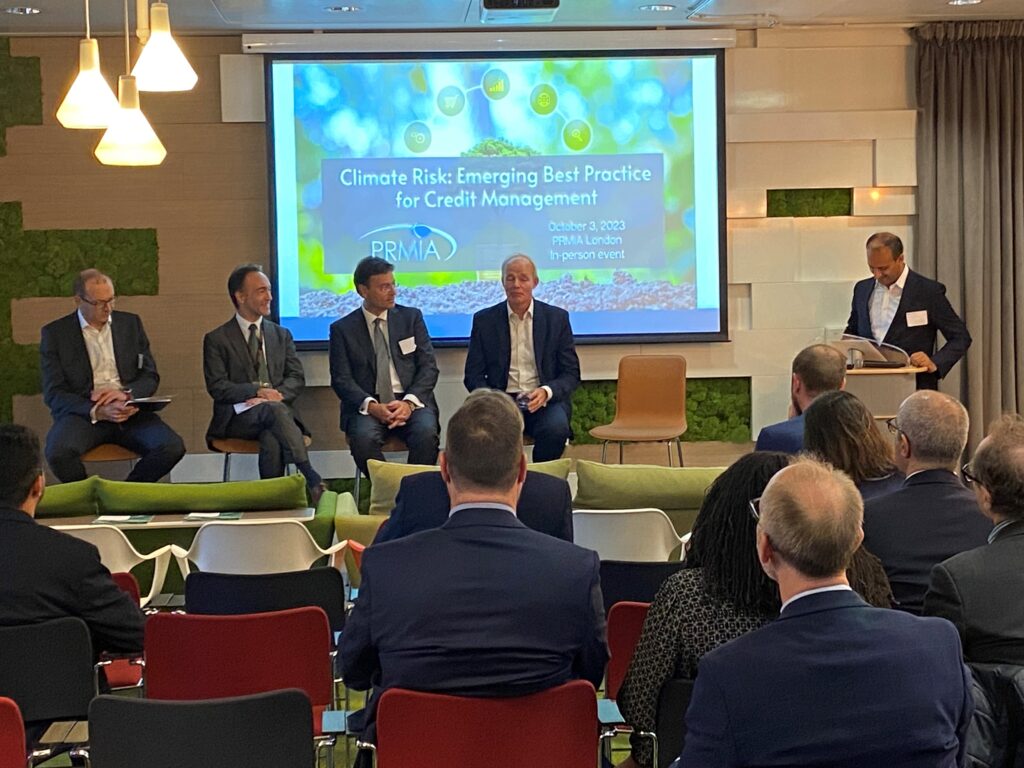Climate Risk: Emerging Best Practice for Credit Management
Written by Karl Sees, Global Head of Product Strategy and Marketing at CubeLogic, and Anne-Marie Barcia, founding partner at Adeva Partners*
Climate Risk: Emerging Best Practice for Credit Management
On Tuesday, 3 October 2023 PRMIA** hosted an evening event and panel discussion on Climate Risk: Emerging Best Practice for Credit Management. The panel included senior bankers and rating agency experts, who shared their experiences with the challenges of integrating climate risk into the credit risk management assessment process. Below is a synopsis of some of the key takeaways from the session.
Emerging data and analytics availability
Bankers and investors are increasingly integrating climate risk into their analysis, while regulators are requiring better transparency and disclosure. Both factors are driving the demand for data that can be input into models to quantify the risks, and thus enhance the decision-making process. Stephen Bullock, from S&P Global Sustainable1, provided insights into their methodology and the building blocks for quantifying climate risk and the likely financial impact. By way of example, he shared information about carbon credit earnings at risk, noting there is a 72% shortfall of required emission reduction, as per the Paris Agreement, and the cost to exposed companies could be material as these prices rise.
Practical challenges and limitations
The data that is currently available is focused on the largest companies with vulnerable exposures to climate hazards around the globe. The ultimate aim is to be able to use the output to help quantify the financial impact and provide “scores”. For the sectors most exposed to these risks, this data can be helpful, but it is only part of the climate change and risk assessment process. As one of the senior bankers noted: You need to “know your customer”, understand and be able to articulate their transition strategy and provide evidence of their progress. For this, gaps in data remain problematic.
For large banks, with many thousands of customers across virtually all industries and operating in multiple countries, the task of quantifying exposure to climate risk is gargantuan. For vulnerable sectors, stress testing, using available data, helps to quantify the risk but an issue everyone acknowledged is the ability to capture subsector and supply chain exposures. From a reporting perspective, scorecards should help identify the risk. Ultimately banks need to both quantify the enterprise-wide risks and satisfy regulators that these risks can be identified, measured, monitored, and managed. Banks still have a tremendous amount of work to do to achieve this.
Execution responsibilities: Role of First Line of Defence
Banks take their commitment to net zero transition very seriously. In practical terms, it was generally agreed that the first Line of Defence has primary responsibility for implementing this policy. This includes the selection process through to formulating credit appetite, capital allocation, and loan pricing. Those in origination, as well as clients, are concerned about what this will mean in the future. One banker noted that with existing clients, it is key to be pragmatic “assisting not insisting” them to achieve their emissions goals. For smaller businesses, education and training are needed.
Governance
The governance around client management, disclosure, and accuracy of data is a priority. Given the problems with huge data gaps, data governance was highlighted as particularly challenging. The panellists agreed that the mantra of being “roughly right rather than precisely wrong” is very apt, and that traditional model validation is currently impossible (auditors and regulators take note!). The heightened model uncertainty has led some firms to establish advisory panels to facilitate discussions with the clients who are most at risk to find workable solutions and support businesses through the transition process. Generally, a cautious approach has been taken in how these new, untested models and methodologies are used to ensure that clients are treated fairly and new learnings are incrementally baked into critical decision-making processes. The law of unintended consequences remains at the top of senior bankers’ minds.
Integrating climate risk into the credit risk assessment process is a work in progress.
*Anne-Marie Barcia is a founding partner at Adeva Partners, specializing in credit, corporate finance, risk, and regulatory training for global financial institutions. With 13+ years at Adeva, she leads consulting projects and designs training supporting clients’ business and risk management strategies. Her extensive background includes a 22-year tenure as Managing Director at Fitch Training and prior roles at Chase Manhattan Bank and JPMorgan Chase & Co. In 1987, she founded CCR, one of Europe’s first companies providing tailored credit and corporate finance training, eventually acquired by Fitch Ratings in 2002. Anne-Marie’s career spans global financial hubs, including New York, Hong Kong, South Asia, and London.
**PRMIA: The Professional Risk Managers’ International Association is a non-profit, member-driven professional organization that focuses on the development and education of the risk management profession.

